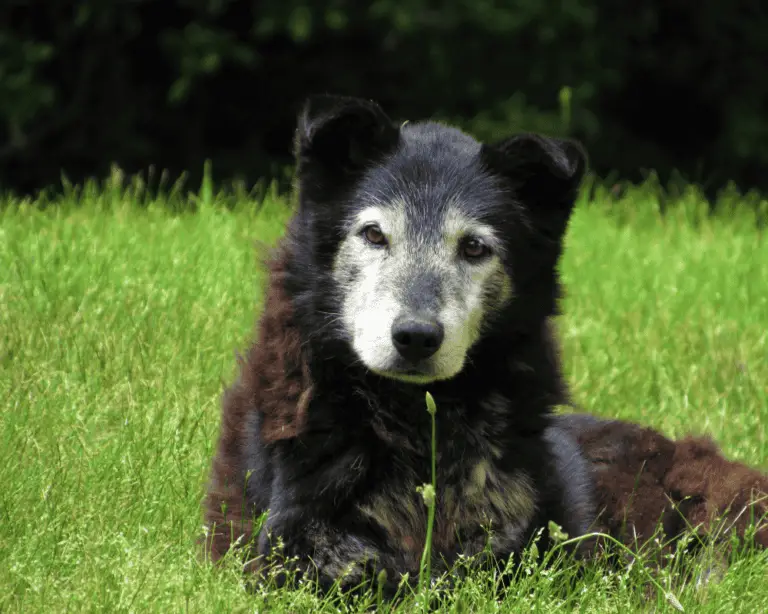10 Signs Your Dog Is Ready to Say Goodbye

Death is a part of life. We already know this when we bring a four-legged friend into our lives. As our dogs age, we tend to read too much into every change in their behavior. Every muscle tremor and whimper gets scrutinized.
If you count yourself among these types of dog owners, please don’t take this the wrong way. It’s great that you’re attentive. That way, you can help your dog quickly if they need it.
But to help you move through daily life with your senior dog a little more calmly, it’s best to read this article. Here you’ll learn which signs can actually indicate that your dog may be slowly getting ready to say goodbye.
#1: Decreased Activity
As they get older, dogs become less active. Their usual walks can become too long, and they may no longer be interested in playing fetch. This is normal—it’s simply a part of aging. Just because your senior doesn’t want to go outside today, it certainly doesn’t mean that farewell is near.
However, if your dog is only lying around all the time, it might mean that the time is approaching. But even so, don’t rely solely on this sign. Loss of motivation for movement in old age can be due to arthritis or other age-related health issues. If moving is painful with every step, your dog will naturally avoid it as much as possible.
By the way, a sudden burst of energy can also indicate the end is near. In the dying process, some dogs perk up, eager to go outside and walk as much as they can. Especially after a very quiet phase, when your dog barely wanted to get up and even left their food untouched, this can signal a goodbye.
#2: Refusing Food
It’s not uncommon for dogs to occasionally leave their bowl untouched. That’s not necessarily a sign that they’re about to pass away. Especially older dogs can lose their appetite quickly, for example if they’ve caught an infection. But if your dog refuses not just food, but also treats and water, that’s when you should be concerned.
Total refusal to eat is part of the natural dying process in dogs. The exact reason why animals won’t take in any food in the first phase of dying isn’t completely understood. Some researchers believe it’s the animal’s way of not wasting energy, since they wouldn’t be able to use it anymore anyway.
I see it more as a reaction to the body breaking down and the stress that comes with it. Under extreme stress, people often forget to eat, too. A dog might not know they’re dying, but they do sense that something isn’t right.
So, a complete refusal to eat in older dogs can suggest that your dog is nearing the end. But it’s just as possible that they’re simply ill.
#3: Physical Decline
As they age, dogs lose muscle mass. This is due to changes in their metabolism—their bodies break down muscle more easily and have a harder time building it back up. This means your dog will lose muscle as a senior, even if they move around just as much as before.
This physical decline is often visible in older dogs. They can look thinner or sunken, especially around the hips and shoulders. But that alone isn’t a definite sign that the end is near.
Physical decline affects all parts of the body. In the weeks or few months leading up to death, your dog will likely become more susceptible to illnesses. They might also:
- have trouble breathing,
- be much less resilient, or
- have trouble walking or keep collapsing.
Don’t automatically see this decline as a sure sign the end is near. Always take symptoms seriously and have your dog checked out by a vet. All of these could also point to treatable health issues.
#4: Increased Need for Sleep
Dogs have widely varying sleep needs. Some only leave their bed when they absolutely must, while others stay quite active even into old age. Breed also plays a part in this. But regardless of breed, most dogs need more sleep as they get older.
On average, it’s said that senior dogs need 20 to 22 hours of sleep a day. A good chunk of that time, though, they’re just dozing or resting, not in a deep sleep. What you want to watch for is a change in your dog’s sleeping habits. If they’re suddenly sleeping a lot more, it’s probably a sign that age is catching up with them.
Sleeping more isn’t a sure indicator that your dog is dying. Keep an eye on their behavior and rule out any treatable causes.
Also, take note if your dog suddenly becomes more active. This could be related to dementia. Dogs with dementia can become restless and wander their home all night with no pause or purpose. Dogs can also become very active during the second stage of dying.
#5: Changes in Behavior
Some dogs go through major behavioral changes shortly before death. This can be connected to progressing dementia. The older a dog gets, the greater the risk they might develop it.
This not-very-surprising conclusion was also reached by the study by Stanislav Katina and other researchers.
The early signs of dementia are easy to miss. Or owners chalk them up to forgetfulness or quirks they think are normal in senior dogs. Even if your senior hasn’t been diagnosed with dementia, it’s very possible they are suffering from it.
These behavioral changes can present in many ways. Some dogs:
- become aggressive,
- howl or bark persistently, or
- suddenly eat or chew on objects.
These behavioral changes might also be signs of pain. A dog with severe back pain, for example, might become aggressive when touched there. Always have these changes checked out by a veterinarian. They’re not necessarily a sign that the dying process has started.
#6: Clinginess or Withdrawal
This sign is another behavioral change, but it can go in completely opposite directions. It isn’t just about your relationship, but also your dog’s personality. Some dogs become very clingy in the weeks before they pass. Others withdraw and hardly take part in family life anymore.
Both behaviors are completely okay, even though withdrawal is definitely harder for us to accept. What’s most important now is what helps your dog. Dying is exhausting. If your dog needs peace and quiet, grant it to them. Of course, you shouldn’t ignore them or leave them completely alone.
Check on them often, talk to them, pet them—if that’s what they want. Show your dog that you’re there if they need you. But don’t force them to leave the spot they’ve chosen if they don’t want to.
#7: Loss of Control Over Bodily Functions
In combination with other symptoms, loss of control over the bowels or bladder is a very certain sign. Yes, dogs can develop a weak bladder with age and sometimes leak a bit of urine while sleeping. But a dog will only lie in their own mess if they truly can’t do otherwise anymore.
If your dog is
- barely responsive,
- can’t get up anymore and/or
- having seizures,
then the added, uncontrolled loss of stool and urine is a very certain sign their end is near.
#8: Shallow Breathing
As a dog dies, their breathing changes. This can be due to undiagnosed health problems. But close to the end, breathing changes even independent of those factors.
A dying dog breathes more shallowly or suddenly takes in deep, gasping breaths—much like the way you’d gulp air after surfacing from underwater. In this state, the dog is usually no longer responsive.
Don’t automatically attribute changed breathing to your dog’s imminent death. There can be lots of reasons, and it absolutely should be checked by a vet. Maybe your dog just has an infection or heart problems. These can tire your dog out so much that it shows in their breathing.
#9: Vacant Stare
A dog who has begun their final journey doesn’t take in much of their surroundings anymore. Their gaze appears vacant to us—they don’t seem to focus on anything and just stare into the distance. They don’t follow their owner’s movement with their eyes anymore, even if you walk right past them.
But don’t take a vacant stare as a sure sign that the end is near. Many dogs suffer from cataracts or other eye issues in old age. For example, untreated or poorly regulated high blood pressure can lead to blindness over time.
Cataracts are known as an inherited eye disease in over 100 dog breeds. As Shirin Hertslet’s doctoral thesis notes, retrievers, huskies, and British herding breeds are especially affected. In advanced cases, your dog might barely be able to see at all.
In such cases, your dog wouldn’t be able to focus on anything either. But blindness alone, of course, doesn’t cause death.
#10: Seizures
Seizures can happen for really harmless reasons. Sometimes it’s a mild mineral deficiency or poor circulation. After overexertion, your dog could also briefly cramp up.
But when we look at what happens right before death, we’re talking about generalized seizures.
These types of seizures are part of the natural dying process. They’re likely triggered by diminishing brain function and a buildup of waste products in the body. Your dog’s body goes stiff and they can’t walk anymore.
Such a seizure should be over in a few minutes. Afterward, I strongly recommend taking your dog to the vet. If the seizure doesn’t have anything to do with their nearing end, it could be due to epilepsy. In that case, your dog would need medication to prevent further seizures.
Conclusion
It’s really not easy to recognize when a dog’s time is approaching. There are plenty of signs that could point to it, but none are conclusive. Many of them could also just be normal symptoms of illness.
So don’t panic if your dog shows some of the behaviors described above. Always look at the whole picture and have your dog checked by your vet. Even older dogs can often be helped.
And even if it’s just about making their final journey as easy as possible. When your dog is struggling to breathe or having seizures, euthanasia is usually the kinder option.






